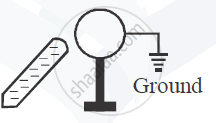Advertisements
Advertisements
प्रश्न
Let the resistance of an electrical component remains constant while the potential difference across the two ends of the component decreases to half of its former value. What change will occur in the current through it?
उत्तर
According to Ohm’s law
V = IR
⇒ I = `V/R` …(1)
Now Potential difference is decreased to half
∴ New potential difference `"Vʹ" = V/2`
Resistance remains constant
So the new current `"Iʹ" = "Vʹ"/"R"`
= `(V/2)/R`
= `(1/2) (V/R)`
= `(1/2) I`
= `I/2`
Therefore, the amount of current flowing through the electrical component is reduced by half.
APPEARS IN
संबंधित प्रश्न
Find the resistance of a conductor if 0.24 A current is passing through it and a potential difference of 24 V is applied across it.
Will current flow more easily through a thick wire or a thin wire of the same material, when connected to the same source? Why?
Name the physical quantity whose unit is "ohm".
State Ohm’s law and draw a neat labelled circuit diagram containing a battery, a key, a voltmeter, an ammeter, a rheostat and an unknown resistance to verify it.
A wire of resistance 3 ohm and length 10 cm is stretched to length 30 cm. Assuming that it has a uniform cross section, what will be its new resistance?
A wire has a length of 2.0 m and a resistance of 5.0 Ω. Find the electric field existing inside the wire if it carries a current of 10 A.
A metal sphere is kept on an insulting stands. A negatively charged rod is brought near it, then the sphere is earthed as shown. On removing the earthing, and taking the negatively charged rod away, what will be the nature of charge on the sphere? Give reason for your answer.

State the limitations of Ohm’s law.
Choose the correct alternative.
Which of the following is an ohmic conductor?
Ohm’s law states the relationship between power and voltage.
State Ohm’s law.
State microscopic form of Ohm’s law.
Two cells each of 5V are connected in series across an 8Ω resistor and three parallel resistors of 4Ω, 6Ω, and 12Ω. Draw a circuit diagram for the above arrangement. Calculate
- the current drawn from the cell
- current through each resistor
Which of the following is correct for V-I graph of a good conductor?
State Ohm’s law? How can it be verified experimentally? Does it hold good under all conditions? Comment.
Suppose there is a circuit consisting of only resistances and batteries and we have to double (or increase it to n-times) all voltages and all resistances. Show that currents are unaltered. Do this for circuit of Example 3.7 in the NCERT Text Book for Class XII.
The voltage - current readings of a certain material are shown in the table given below:
| Voltage (V) | 10 V | 20 V | 30 V |
| Current (I) | 2 A | 3 A | 4 A |
Study the table.
- State whether the conductor used is ohmic or non-ohmic.
- Justify your answer.
- State Ohm's law.
